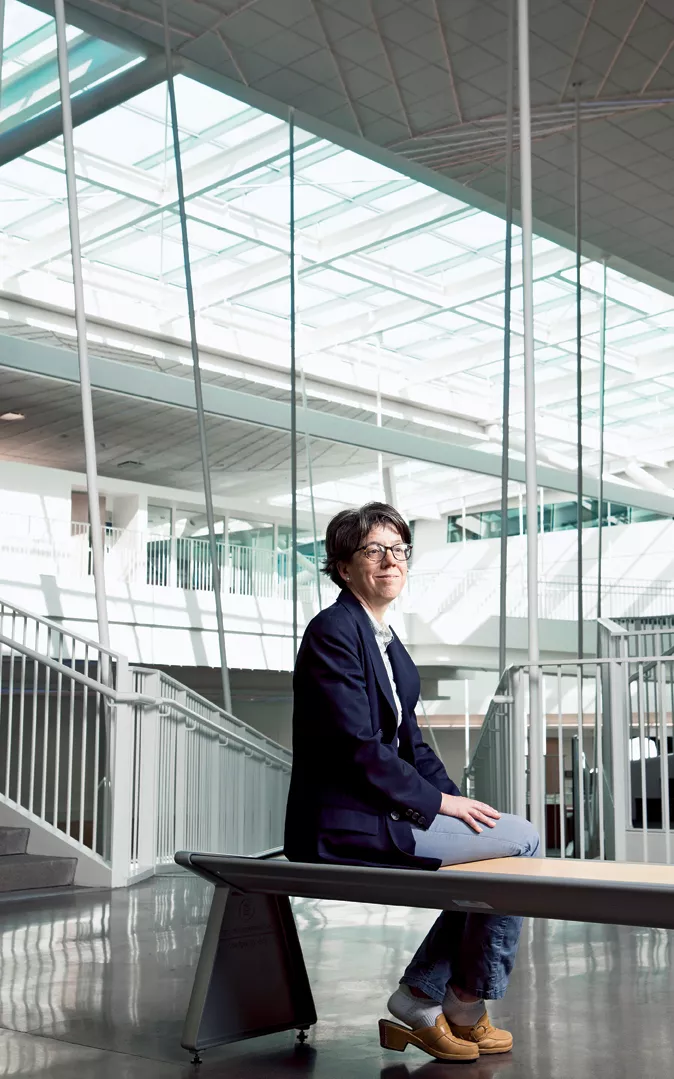An Architect Lights Up a University
Every day, the clean energy revolution is creating new jobs for American workers. As part of an ongoing series, we asked one of them to tell us her story.

Lisa Petterson, a sustainability-design architect in Portland, Oregon. | Photo by Terry Manier
Adapted from an interview with Lisa Petterson by Kristine Wong.
I started early on the path to becoming an architect. At age eight or nine, I began drawing houseplants, then started to sketch houses while on trips with my family. I grew up in Montana, so it was fascinating to go to the Southwest or California. The moment I heard about sustainable design, while in architecture school at the University of Oregon, I knew it was what I wanted to do.
When I was a freshman at Oregon, my architecture class visited the Mount Angel Abbey Library, designed by the Finnish architect Alvar Aalto. It helped shape my career. I just loved the way the building was shaped for light to enter. Aalto was very good at integrating electric light with natural light. Studying how he did that led me to become passionate about daylighting, maximizing the ability of natural light to illuminate interior spaces. It's my area of expertise.
Daylighting is one of the key features of the Collaborative Life Sciences Building—a project I worked on for Oregon Health & Science University, Oregon State University, and Portland State University—which won an American Institute of Architects Top Ten award this year. Working with CO Architects, we used sustainable principles to site the project. That drove the building's form, with natural light penetrating in an east-west direction. There's a five-story central atrium so that when the warm air rises to the top, it can be captured and reused.
Right now my firm is working on a renovation and addition to the University of Oregon's student union. We're making the existing part of the building more energy efficient and adding a new wing—but there will be no increase in the building's energy use after we add square footage. The University of Oregon follows a principle of "no net energy increase" on campus, which makes it think in a holistic way—how it can make all of its structures more energy efficient, not just the new ones.
Because they build for longevity, universities can be incubators of sustainable-design projects. They recognize that it's important to invest in energy and water efficiency, which leads to less maintenance and reduces costs over time. They also see sustainable design as a way to differentiate themselves from their peers.
Sustainability in architecture is more prevalent on the West Coast than on the East Coast. But worldwide, Germany stands out—all office workers must have access to natural light and air and sit within 10 meters (33 feet) of an operable window.
I have a big interest in photography. For me, it's really about capturing light and how different subjects interact in light. I like older, large-format cameras, because you really need to understand light to expose film. With digital photography, you can try over and over again until you get it right, so you don't have to understand light in the same way.
My vacations are planned around places to photograph. I love eastern Oregon in particular. In the Painted Hills, part of John Day Fossil Beds National Monument, you can see light interact with the color of the mountains. Leslie Gulch, near the Idaho border, is another place I enjoy, along with the Strawberry Mountain Wilderness, which has two lakes and a waterfall.
I love hiking on the weekends, but over the last year my husband and I have spent most weekends renovating our house in Portland. It took a year to complete. The house is "net-zero ready," which means that I still have to buy the photovoltaic system to make it "net zero." I'm planning to do that next year.
Nature is always an inspiration in my design. When my husband and I were walking at New River on the Oregon coast, the bark of a manzanita tree—a reddish-cranberry tone on one side and a brown-copperish color on the other—inspired us to make the roof of our house a copper color and to paint the windows cranberry. I'm also sparked by the feeling of light under a dappled treescape. How to bring all that out in a building is something I strive for.
This article was funded by the Sierra Club's Beyond Coal campaign.
 The Magazine of The Sierra Club
The Magazine of The Sierra Club



